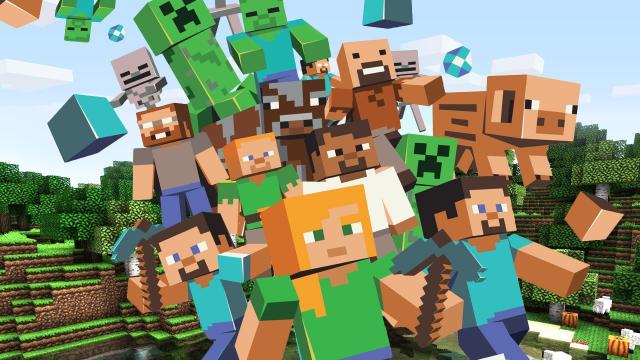Today in the New York Times Magazine there’s a pretty great story about the Minecraft phenomenon, approached deftly by Clive Thompson in a way that offers new insight into a story we’ve all heard thousands of times before.
Among the revelations, for example: Minecraft sells 10,000 copies a day — 10,000 a day! — which is an astronomically ridiculous number for a game that has been out since 2011. The average age of a Minecraft player, Microsoft told the Times, is between 28 and 29. Around 40 per cent of players are women.
One of the most interesting points Thompson makes is that much of Minecraft‘s appeal, especially to kids, comes from its inscrutability. Primary-schoolers and teenagers like Minecraft not in spite of the obtuse interface and inadequate explanation, but because of them. As Thompson writes:
Minecraft is an incredibly complex game, but it’s also — at first — inscrutable. When you begin, no pop-ups explain what to do; there isn’t even a “help” section. You just have to figure things out yourself. (The exceptions are the Xbox and PlayStation versions, which in December added tutorials.) This unwelcoming air contrasts with most large games these days, which tend to come with elaborate training sessions on how to move, how to aim, how to shoot. In Minecraft, nothing explains that skeletons will kill you, or that if you dig deep enough you might hit lava (which will also kill you), or even that you can craft a pickax.
This “you’re on your own” ethos resulted from early financial limitations: Working alone, Persson had no budget to design tutorials. That omission turned out be an inadvertent stroke of genius, however, because it engendered a significant feature of Minecraft culture, which is that new players have to learn how to play. Minecraft, as the novelist and technology writer Robin Sloan has observed, is “a game about secret knowledge.” So like many modern mysteries, it has inspired extensive information-sharing. Players excitedly pass along tips or strategies at school. They post their discoveries in forums and detail them on wikis. (The biggest one, hosted at the site Gamepedia, has nearly 5,000 articles; its entry on Minecraft’s “horses,” for instance, is about 3,600 words long.) Around 2011, publishers began issuing handbooks and strategy guides for the game, which became runaway best sellers; one book on redstone has outsold literary hits like “The Goldfinch,” by Donna Tartt.
“In Minecraft, knowledge becomes social currency,” says Michael Dezuanni, an associate professor of digital media at Queensland University of Technology in Australia. Dezuanni has studied how middle-school girls play the game, watching as they engaged in nuanced, Talmudic breakdowns of a particular creation. This is, he realised, a significant part of the game’s draw: It offers many opportunities to display expertise, when you uncover a new technique or strategy and share it with peers.
It’s a game about secret knowledge! That’s one of the best takes I’ve read to date on the success of Minecraft. Like Bloodborne, Dark Souls and so many NES and PC games of the past, this is a game that respects players’ intelligence, and for that reason it’s become a sensation.
(Read the full story here.)

Comments
6 responses to “Minecraft Sells 10,000 Copies A Day”
“an inadvertent stroke of genius” I thought it was common knowledge amongst gamers that tutorials sucked.
Also: Not making a tutorial because it’s beyond your budget is a stroke of genius!
More than ever I think people need ways to escape from the mess that is the real word. Yes Minecraft has it’s complexities, but there’s little ambiguity. Everything works the way it is supposed to work. I think that, combined with the creative opportunities it provides (think about how little creating we actually get to do in “real life” these days) and the general sense of escapism is what makes it so appealing. I’m not articulate enough to capture exactly what Minecraft’s popularity represents – but I think it goes a lot deeper than the currency of knowledge etc.
Also, in 50 years, if you want to make a bunch of old people cry, play them the Minecraft soundtrack.
Ah, Minecraft. I remember when I helped my friend build a gigantic castle on a server on survival. Good times.
“In Minecraft, nothing explains that skeletons will kill you”. But isn’t that kinda something we grow up knowing from the use of symbolism in both everyday life (danger signs) and in watching movies or playing other games?
Its kinda like knowing the spiders in the game can be dangerous because spiders in real life can be dangerous.
This. Really the only learning curve creature wise is when you see adorable green cactus creatures and barely get the chance to think “Are you friendly or…” before you go BOOM. And voila. Then you know. No tutorial needed.